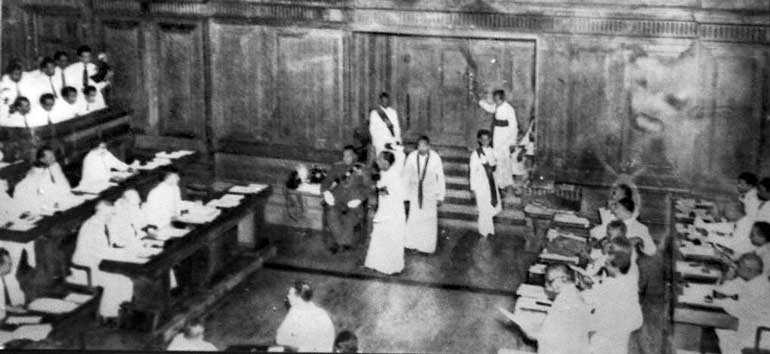Friday Dec 05, 2025
Friday Dec 05, 2025
Monday, 12 November 2018 01:17 - - {{hitsCtrl.values.hits}}

S.W.R.D. Bandaranaike crossing Well of House followed by D.A. Rajapaksa, father of Mahinda Rajapaksa
By a Special Correspondent
The founder of the Sri Lanka Freedom Party (SLFP), S.W.R.D. Bandaranaike, in his speech made at its inauguration on 2 September 1951, said the day not only marked the birth of a new political party but “it also ushers, in many ways, a new political era.” He was not wrong.
Less than five years after its founding, the SLFP won a landslide victory in the 1956 general elections and with it revolutionised politics in the country by ushering in the era of the “common man”. It was no easy task given the larger-than-life figures who led his rival United National Party (UNP) which had dominated post-independence Lankan politics until then.
Less than two months prior to inaugurating the SLFP, Bandaranaike had taken the drastic step of crossing the Well of the House and taking up a seat in the opposition benches closely followed by D.A. Rajapaksa, his erstwhile colleague, father of Mahinda Rajapaksa. Bandaranaike left behind his post of Minister of Health and Local Government and that of Leader of the House that he held in the country’s first Cabinet under the leadership of D.S. Senanayake. But his gamble paid off and the SLFP, in the long run, became entrenched as the democratic alternative to the UNP and for the past 70 years has, alternatively, ruled the country with the UNP.
Over the years, the party’s leadership has changed hands, first going to Mrs. Sirimavo Bandaranaike, the widow of S.W.R.D who was assassinated in 1959, then to Chandrika Kumaratunga, his younger daughter and from her to Mahinda Rajapaksa.
The mantle of SLFP leadership went to President Maithripala Sirisena after his victory at the 2015 Presidential Election, the only “outsider” to get the coveted post. But with him at the helm, the end of the SLFP now seems nigh.
That the SLFP was weakening without strong leadership was clear from the results of the Local Government Elections held early this year. The SLFP won only six local authorities as opposed to the 231 won by the SLPP which was then backed by Rajapaksa even though he remained a member of the SLFP. The SLFP since its inception has been in government with coalition partners drawn from left-leaning parties but it managed to remain the dominant partner. However, after the 2015 Presidential Election, when Sirisena, who was then the General Secretary of the SLFP, decided to leave the SLFP-led United People’s Freedom Alliance (UPFA) camp to become a common candidate, party support was split and a large segment chose to remain loyal to Rajapaksa. After his victory, Sirisena insisted on and got the leadership of the SLFP into his hands but in spite of being its official leader, he never won the hearts and minds of its members.
Maybe the President was hoping for a turnaround in his fortunes viz a viz the SLFP after his dramatic patch up with Mahinda Rajapaksa two weeks ago, appointing his archrival as Prime Minister. But since the dissolution of Parliament on Friday and politicians scrambling to get nominations, it looks like the SLFP will be the last party that anyone would be interested to contest from.
Shifting political landscape
Mahinda Rajapaksa, whose father was a founding member of the SLFP with Bandaranaike and who himself led the party for 10 years prior to President Sirisena, abandoned the SLFP yesterday and took up membership of the blooming bud in Sri Lanka’s political landscape, the Sri Lanka Podujana Peramuna (SLPP). Along with him, nearly 50 others took membership of the SLPP from its Chairman G.L. Peiris. Each was issued a membership card with their name on it and a line saying, “This is to certify that you are a founding members of the Sri Lanka Podujana Peramuna.”
A day after the sudden dissolution of Parliament, it became clear that the Prime Minister in Sirisena’s caretaker government and his family members were no longer interested in the SLFP. Namal Rajapaksa was the first to announce he was joining the SLPP on Saturday. “I am joining the Podujana Party effective immediately,” he announced, to be soon followed by ex-MPs such as Shehan Semasinghe and D.V. Chanaka, all members of Namal Rajapaksa’s inner circle. He accepted his membership card from his father last morning. By yesterday, except for a few Sirisena and SLFP loyalists, the others were leaving the sinking SLFP ship en masse.
There is no doubt that Mahinda Rajapaksa, who wrested the SLFP leadership from the hands of the Bandaranaikes, is now looking to replace it with the SLPP that he founded. Not only would he be looking to leave behind a party that will always be linked to his name but also make the path clear for his heir apparent, Namal Rajapaksa, to claim its leadership after him.
“Very powerful forces are likely to be ranged against us in the time to come – power and influence, money, distortion and misinterpretation,” Bandaranaike said on the day the SLFP was inaugurated. His words were aimed at the powerful forces aligned with the UNP at the time. Little would he have expected that the death knell for the SLFP would be dealt by its own members.